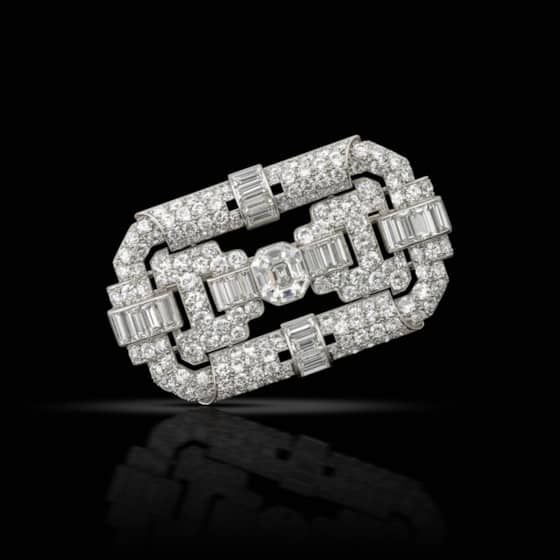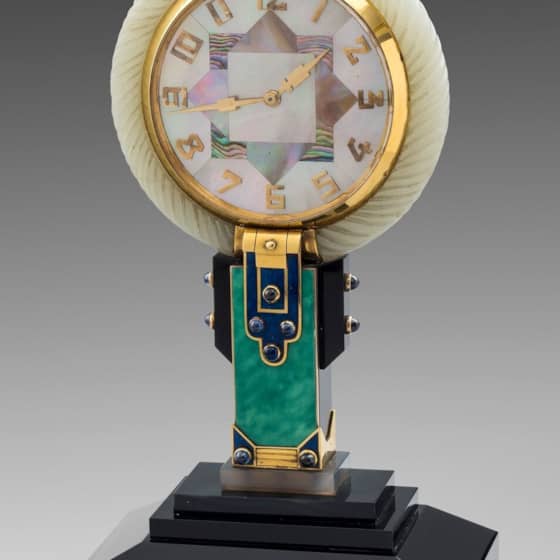Lacloche Frères
The story of any jewellery firm is usually the story of a family, and the story of Lacloche Frères is no exception. The Lacloche brothers in question were Jules and Léopold Lacloche, who moved to Paris in 1892 to open their eponymous business, working as ‘joialliers fabricants’. They were two of six siblings, all of whom would also end up working in the jewellery industry. In Madrid their brothers Jacques and Fernand were selling Parisian jewels as Lacloche & Cie from 1895, while their sister Bertha married Jacob Jacques Walewyk to sell wedding trousseaus as Walewyk-Lacloche, and their other sister Emilie was selling jewels alongside her husband as Coven-Lacloche. Throughout the opening decades of the 20th century, the Lacloche family continued to expand their network of branches and related businesses, covering the resorts of northern and southern France, such as Deauville, Biarritz and Nice, as well as Paris, Madrid, London, New York and even Buenos Aires. Underpinning this clever strategy of ‘following the money’ by opening branches in fashionable resort towns frequented by wealthy holidaymakers as well as capital cities, was their fundamentally excellent taste in jewellery design, collaborating with the best Parisian workshops including Strauss Allard Meyer, René Lalique and Verger Frères to create some of the most important jewels of the early 20th century. Among their most famous works are their ‘petit point’ jewels, constructed of intricate platinum grids imitating lace work, ‘embroidered’ with diamonds in various patterns. These were undoubtedly inspired by the work of Fabergé, whose London stock was acquired by Lacloche Frères in 1917. Equally beloved are their imaginative animal-themed gold accessories created in collaboration with Julien Duval and Paul Frey, but perhaps their most sought-after pieces are their sumptuous Art Deco jewels in the Chinoiserie and Egyptian revival styles, intricately set with jadeite, diamonds, and buff-topped calibré-cut coloured stones. Their most prestigious commission came in 1930, when the Duke of Westminster commissioned an extraordinary ‘halo’ tiara from the firm for his bride Loella Ponsonby, which was set with the famed Arcot diamonds. This commission was the culmination of decades of work, creating a network of jewellery businesses across some of the most desirable locations in Europe, and carefully building a glamorous clientele including members of royal and prominent aristocratic families. Soon after this peak, however, came a crash. The leading members of the family firm, enjoying their dazzling success, had all developed heavy gambling habits, and their losses soon dragged the business down. In 1931, Lacloche shocked the jewellery world by declaring bankruptcy. The company was dissolved, its remaining stock was sold off, and the heyday of Lacloche Frères came to a sudden end. There was one member of the family who endured: Jacques Lacloche, son of one of the founding brothers, who continued to design jewellery in the colourful contemporary styles of the 1930s-1950s. Despite persecution and imprisonment during the war (being of Jewish heritage), he survived to find success on his own terms, and his jewellery business counted Princess Grace of Monaco among his many glamorous clients. The family’s legacy has received renewed attention with a recent exhibition at the Ecole Van Cleef & Arpels in Paris, as well as a lavish new book, Lacloche Joailliers by Laurence Mouillefarine and Veronique Ristelhueber, and jewels by Lacloche continue to excite and inspire new generations of collectors.
Lacloche Frères
Lacloche Frères




































































